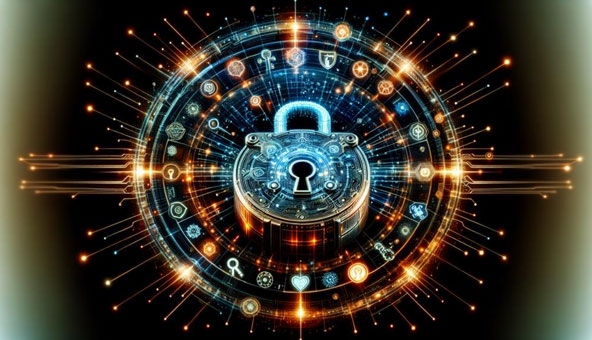Imagine the world of cybersecurity as a vast ocean, where traditional encryption methods are like a wooden boat navigating through turbulent waters.
Now, picture quantum secure messaging as a sleek, state-of-the-art submarine, cutting through the depths with unparalleled speed and stealth.
As you ponder the implications of this quantum leap in security, consider how quantum key distribution and cryptography are poised to revolutionize secure communication.
Stay tuned to uncover the intricate web of benefits and challenges that come with exploring the uncharted territory of quantum secure messaging.
The Rise of Quantum Secure Messaging
The rise of quantum secure messaging has revolutionized the way data is protected in communication networks. Quantum encryption, a key component of this advancement, utilizes the principles of quantum mechanics to secure communication channels beyond what classical encryption methods can achieve. Unlike traditional encryption techniques that rely on mathematical complexity for security, quantum encryption leverages the fundamental properties of quantum particles to ensure secure communication.
Quantum secure messaging operates on the principle of quantum key distribution, where encryption keys are generated using quantum properties such as superposition and entanglement. This method provides a level of security that’s theoretically unbreakable, offering a new frontier in safeguarding sensitive information. By harnessing the laws of quantum physics, secure communication can be established with a high degree of certainty that any interception or eavesdropping attempts would be immediately detectable.
Incorporating quantum encryption into communication networks marks a significant milestone in cybersecurity, paving the way for a future where data privacy is paramount and vulnerabilities are minimized. The integration of quantum secure messaging not only enhances the protection of information but also sets a new standard for secure communication in the digital age.
Understanding Quantum Key Distribution
Utilizing quantum properties such as superposition and entanglement, quantum key distribution establishes a highly secure method for generating encryption keys in communication networks. Quantum key distribution (QKD) leverages the principles of quantum mechanics to enable secure communication between parties. Unlike traditional cryptographic methods, which rely on mathematical complexity, QKD offers a theoretically unbreakable way to distribute keys. By encoding information in quantum bits (qubits) and transmitting them over quantum channels, QKD ensures that any interception or measurement of the qubits would alter their state, alerting both sender and receiver to potential eavesdropping attempts.
In secure communication, the cornerstone of quantum key distribution lies in its ability to detect any unauthorized access to the encryption keys. This process, known as quantum key distribution protocol, establishes a secure key between communicating parties by utilizing quantum properties to detect any third-party interference. By integrating quantum key distribution into communication networks, organizations can achieve unprecedented levels of security and confidentiality in their data exchanges.
Benefits of Quantum Cryptography
In the realm of secure communication networks, quantum cryptography offers unparalleled advantages that redefine the landscape of encryption technologies. Quantum cryptography provides enhanced encryption through the utilization of quantum key distribution protocols. Unlike traditional encryption methods, which rely on mathematical complexity for security, quantum cryptography leverages the principles of quantum mechanics to ensure unbreakable security.
One of the primary benefits of quantum cryptography is its ability to detect any eavesdropping attempts. Through the fundamental principles of quantum entanglement and superposition, any interception or measurement of quantum states alters the information being transmitted, alerting both parties to the presence of an intruder. This feature guarantees secure communication channels, making it virtually impossible for any unauthorized access to go undetected.
Moreover, quantum cryptography offers a level of security that’s theoretically impenetrable. By harnessing the properties of quantum particles to establish secure communication channels, quantum cryptography provides a robust defense against potential cyber threats, ensuring the confidentiality and integrity of sensitive data.
Quantum Secure Messaging Applications
Harnessing the principles of quantum mechanics, secure messaging applications built on quantum cryptography offer unprecedented levels of protection against data breaches and unauthorized access. Quantum secure messaging applications utilize advanced encryption protocols that leverage the unique properties of quantum particles to secure communication channels. Unlike traditional encryption methods, quantum cryptography ensures that messages can’t be intercepted or tampered with without detection.
One key aspect of quantum secure messaging applications is their ability to establish secure communication channels over quantum networks. Quantum network security plays a crucial role in safeguarding the transmission of sensitive information, enabling secure messaging between users across vast distances. By leveraging quantum entanglement and superposition, these applications can achieve levels of security that are practically unattainable with classical encryption techniques.
Future Outlook and Challenges
Looking towards the future of quantum secure messaging, exploring the potential advancements and overcoming emerging challenges is imperative in ensuring the continued evolution of secure communication technologies. As quantum technology advancements progress, one of the key challenges lies in scaling quantum secure messaging systems to accommodate the increasing demand for secure communication channels. The current quantum key distribution (QKD) protocols face limitations in terms of distance and speed, necessitating the development of new protocols that can overcome these constraints.
Future challenges also include the need for enhancing quantum encryption techniques to ensure resistance against quantum attacks. As quantum computers become more powerful, the threat of quantum decryption increases, highlighting the importance of continuously improving quantum-resistant encryption algorithms. Additionally, the integration of quantum secure messaging into existing communication infrastructures poses a challenge in terms of compatibility and interoperability.
Addressing these challenges will require collaboration between researchers, industry experts, and policymakers to drive innovation in quantum secure messaging technologies. By proactively tackling these future challenges, the potential for quantum secure messaging to revolutionize the landscape of secure communication remains within reach.
Conclusion
You have now delved into the world of quantum secure messaging, a revolutionary technology that promises unparalleled levels of security for communication.
With the rise of quantum key distribution and the benefits of quantum cryptography, the future holds endless possibilities for secure messaging applications.
As we navigate through the challenges ahead, the potential for quantum secure messaging to transform the landscape of cybersecurity is both exciting and promising.
Stay tuned for what the future may bring in this quantum leap in security.





